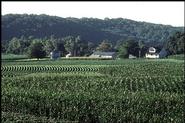
Robert Brande '08 (Glen Rock, N.J.) got a surprise visit from his aunt and uncle last year when they brought him some objects they had dug up on their Missouri farm. Brande, an archaeology major, did what he was trained to do: he examined and asked questions. "I thought, what if I could turn this into a project?" Later, Brande applied for and received an Emerson Grant to investigate this farm in the hopes of determining "how different people have used the land in different ways over time."
There are two parts of the farm in which Brande is particularly interested. The first is the foundations of a ruined house, the second a rock shelter on the property. Brande has split his work into two parts: historical and archaeological. Though the archaeological side of his work is more time-consuming, Brande did spend the first few weeks of his research stint reading and conducting interviews with the town historical society and local residents.
He has also been out in the field, clearing brush and "testing operations to see what's below the ground." The discovery of the house itself was something of a surprise; foundations in a field were one of the artifacts Brande's relatives reported last year. Originally both Brande and his aunt and uncle believed the stone to show a small room about 8 feet by 5 feet, but they were surprised to find that the foundations extended to those of a good-sized house. "It kind of exploded," Brande says, "in a good way."
This summer Brande has certainly been finding artifacts. He has "more nails than I can ever do anything with," and glass bottles, which he enjoys because they can be dated. The name on the bottles is patented to a certain year, and the year of the patent then puts a date to the bottle which in turn can date the house. Brande's favorite artifact is an eye-glass lens, a personal item which speaks to him of the former inhabitants of the house.
His belief is that the house was built in the early to mid 1800's and abandoned at the turn of the century. It was, he explains, "the nicest house in the valley," and the outbuildings and stone foundations as well as the ornamentation suggest affluence. There was also a smaller house with a spring flowing through, which supplied water for the household. Brande hypothesizes that the house was abandoned when the spring dried up.
Most recently, Brande has been investigating the triangular rock shelter. He has "no idea" how old it is, but suspects that it was used by Native Americans, who were in Missouri until the early 1700s. The cave floor is littered with debris, including what appears to be the residue from carving stone tools. "It could be anywhere from a couple hundred years old to several thousand years old."
The largest challenge to the study is the weather. The heat is bad enough, says Brande, but "the bigger problem is the rain," which makes the soil harder to sift for artifacts. Brande also finds that he has a good deal more to do than his 10-week grant allows. He plans to do much of his analysis in August and is considering declaring an independent study for fall semester for further analysis.
Still, Brande is happy with his summer. "Working with Professor Jones has been amazing," he says of his project advisor, George Jones, professor of archaeology. Brande has worked with Jones before, in the Hamilton archaeology field school in Nevada. "If it weren't for [the field school], I wouldn't be doing this right now," Brande adds. Overall, "I couldn't believe someone would pay me for this – I'm totally thrilled."
On campus, Brande is a member of the Hamilton Choir and a member of the Newman Council. He hopes to go to graduate school for archaeology and explains that his ultimate goal is to "make archaeology more accessible to the average person." Digging up his aunt and uncle's back yard, he certainly seems headed on the right track.
His research is funded by the Emerson Foundation Grant Program, which allows students to work closely with a faculty member researching in depth an area of the student's interest.
- Lisbeth Redfield
Posted August 11, 2006
